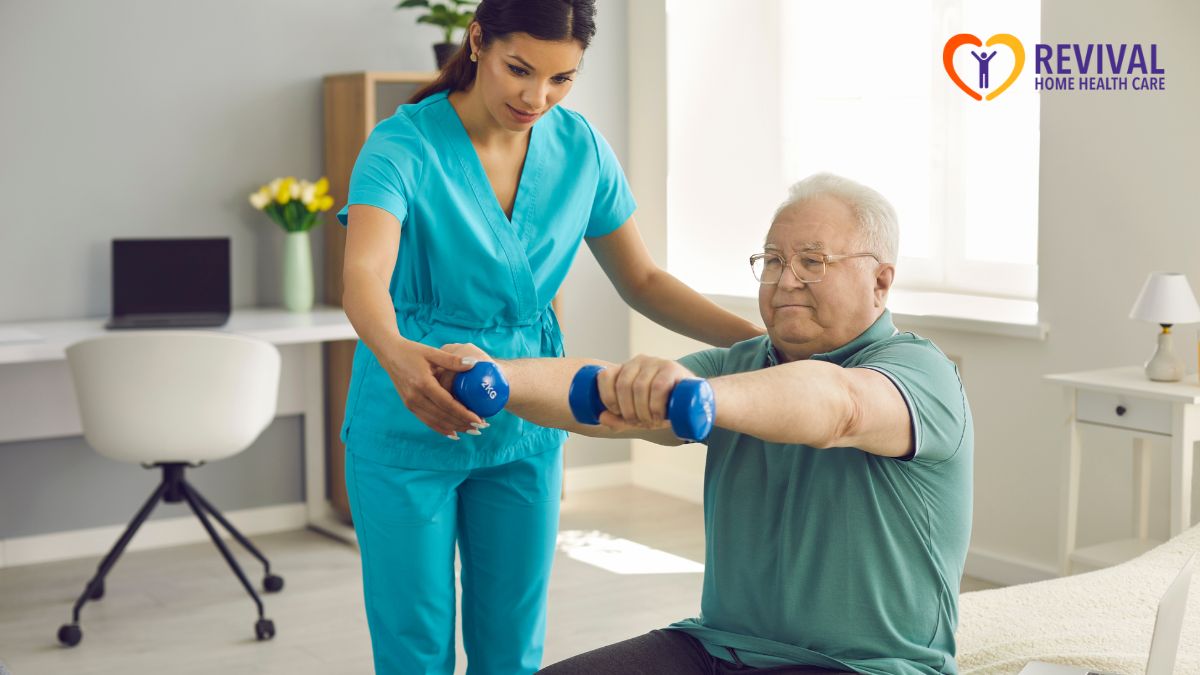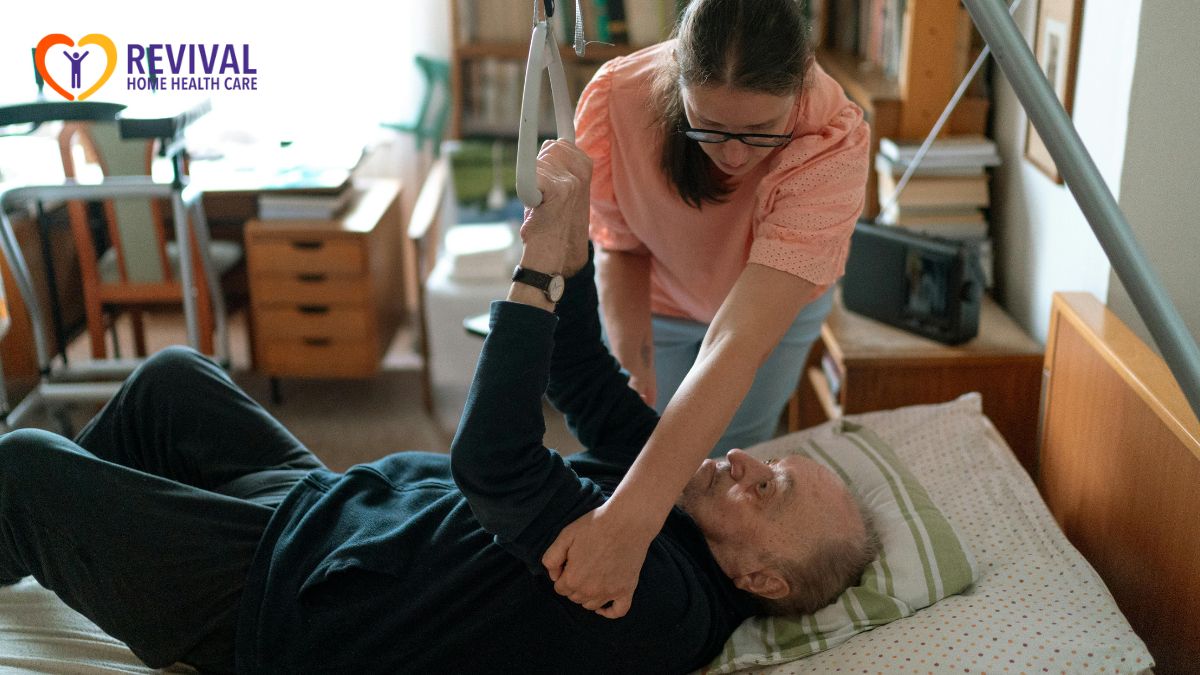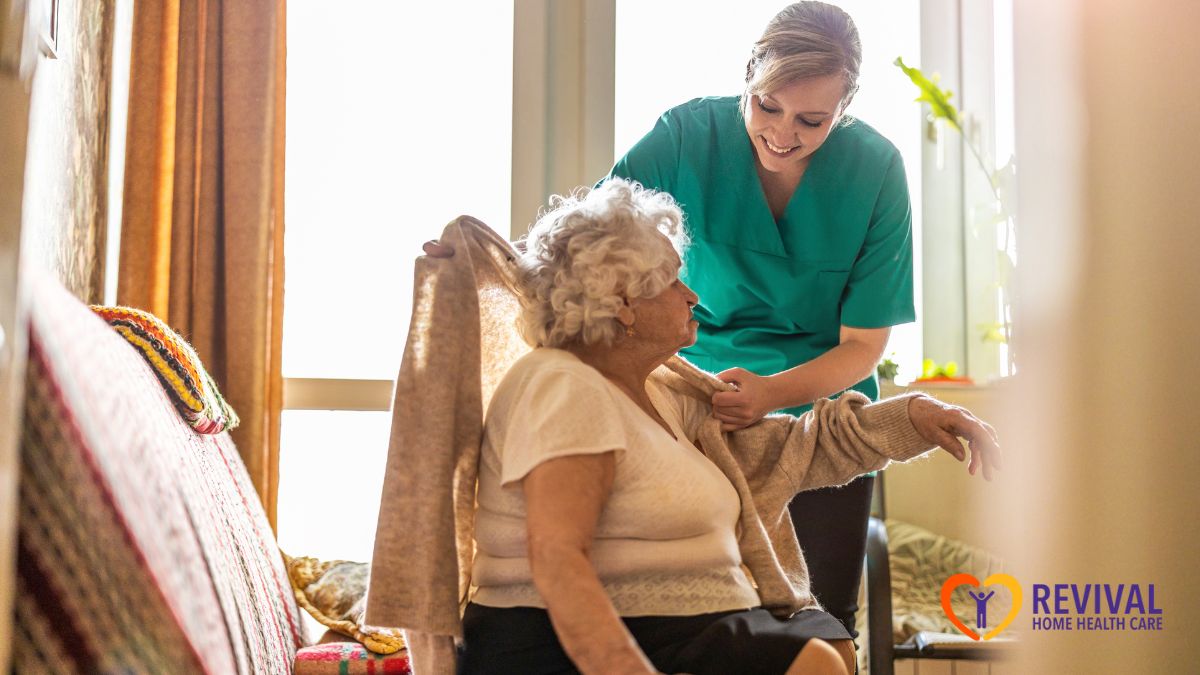Key Points:
- Home health care services include skilled nursing, therapy, infusion, and wound care, plus non-skilled help with bathing, dressing, and safety.
- Skilled care usually starts with two to three weekly visits and tapers as patients improve.
- Medicare covers part-time, goal-based plans with set hourly and weekly limits.
Types of home health care services include skilled nursing, physical and occupational therapy, speech therapy, social services, and home health aide support. Skilled services address medical needs under a physician’s plan, while non-skilled care helps with bathing, meals, and safety.
Home health care keeps care at home while bringing licensed clinicians to the door. The goal is recovery, stability, and independence. This guide breaks down each service, gives real-world examples, and shows typical visit frequency so families can plan the week and avoid surprises.
 Skilled vs. Non-Skilled
Skilled vs. Non-Skilled
Skilled and non-skilled services can work together in one care plan, but they serve different needs and follow different rules.
Skilled services require licensed clinical training and follow a physician-approved plan of care. These often follow short, goal-oriented plans. Typical patterns include two to three visits per week at the start, then fewer as the person improves.
On the other hand, non-skilled services focus on personal care and daily activities. These can be more frequent when there is a need for bathing help, light meals, or supervision for safety.
Medicare defines home health as part-time care. It covers up to 8 hours a day and 28 hours a week for skilled nursing and aide services, with a short-term limit of 35 hours if needed. In 2021, about 3 million people used home health through 11,474 certified agencies. In 2020, 8.3% of Medicare fee-for-service beneficiaries used it, showing the service is common and widely available.
Types of Home Health Care Services
Here’s a look at the types of home health care services to help you map what’s required for your daily medical needs:
- Skilled Nursing (RN/LPN). Nurses handle conditions needing judgment. Plans often start with two to three visits a week for medications, wound checks, and symptom coaching, then taper. Care includes blood pressure adjustment, diabetes teaching, catheter care, heart failure checks, and incision monitoring.
- Physical Therapy (PT). PT improves strength, balance, and safe movement. Plans begin with two to three sessions a week, then taper. Care includes walker training, fall-prevention drills, stair practice, and home safety changes.
- Occupational Therapy (OT). OT supports daily activities. Frequency often matches PT. Care includes safe bathing, kitchen tasks after stroke, arthritis joint protection, and adaptive tool use.
- Speech-Language Pathology (SLP). SLP helps with speech, swallowing, and memory. Plans often start with one or two visits a week. Care includes swallow safety, word-finding drills, and strategies for taking pills.
- Medical Social Services (MSW). Social workers connect families to resources and provide support. Most plans include one to two visits in the first month. Services include caregiver coaching, planning for care, and links to community programs.
- Home Health Aide (HHA). Aides provide personal care under a nurse or therapist plan. Schedules often include a few hours on several days a week. Care includes bathing, dressing, grooming, and skin checks.
How these types of health services connect:
- Nurses manage clinical stability, therapists build function, and aides protect routine and hygiene.
- Social worker solves practical barriers so care continues smoothly.
- The plan flexes weekly so goals drive the visit cadence, not the calendar.
Skilled Nursing at Home: Assessment, Treatment, and Teaching
Skilled nursing anchors most plans. A typical course starts right after discharge or a new diagnosis. Nurses complete the first comprehensive assessment, set teaching goals, and schedule early visits to prevent setbacks.
What skilled nursing includes:
- Medication education and setup, including insulin or new heart medicines
- Wound care, dressing changes, and negative pressure wound therapy when ordered
- Disease monitoring such as weight logs for heart failure home care or oxygen checks for COPD
- Ostomy care, catheter care, drain care, and infection prevention steps
- Safety checks across the home and quick coaching on red-flag symptoms
Visit frequency families see most:
- Early period: two to three visits per week until stable
- Step-down: weekly or every other week as tasks shift to the person and caregiver
- Timing guardrails: intermittent care under Medicare means fewer than seven days per week and less than eight hours per day for a finite short period.
One review found that early outpatient follow-up visits were associated with a 21% lower risk of 30-day readmission for heart failure and stroke. Coordinated home health nursing often links those clinic visits with at-home monitoring and teaching.
 Therapy at Home: PT, OT, and Speech That Changes Daily Life
Therapy at Home: PT, OT, and Speech That Changes Daily Life
Therapy answers a common concern: “What are the different types of home care that rebuild independence?” The therapist’s job is function. The work starts with a clear baseline, a home walkthrough, and a plan that feels doable in 15- to 30-minute practice blocks between visits.
Physical Therapy focus:
- Balance and gait training with the actual hallway, steps, and yard
- Strength and endurance sets scaled to energy levels
- Fall-prevention practice with real-world tasks like carrying laundry or getting into a car
Occupational Therapy focus:
- Bathing and dressing with safer sequences and simple energy pacing
- Kitchen tasks like safe knife grips, one-hand cutting boards, and microwave safety
- Cognitive anchors, such as pill organizers, whiteboards, and phone alarms
Speech-Language Pathology focus:
- Swallow safety drills with foods already in the home
- Speech clarity and breath support exercises
- Memory systems that tie to real routines, not worksheets
Common schedule:
- Two to three visits per week at the start across PT/OT/SLP, then taper as home exercise programs take hold
- Simple daily practice lists taped to the fridge keep progress steady between visits
- Therapists coordinate with nursing to avoid stacked, tiring visits on the same day
Infusion, Wound Care, and Complex Care at Home
Skilled nurses can deliver many treatments safely at home when a physician orders them and supplies are in place.
Common examples of healthcare services in this bucket:
- Infusion therapy, IV antibiotics for post-hospital infections when labs and delivery support are lined up
- Line care for PICCs or ports, including flushes, dressing changes, and infection checks
- Wound care and treatments ranging from simple dressings to negative pressure systems with leak checks
What a week looks like:
- Front-loaded nurse visits for new lines or new antibiotics
- Teaching for caregivers on hand hygiene, symptom logs, and when to call
- Pharmacy coordination for supplies and delivery timing that matches the dosing plan
Digital tools also help. Meta-analyses show that telemedicine and home monitoring programs can reduce hospitalizations for chronic conditions, which pairs naturally with nurse-led home care and therapy. These results vary by condition and program design but point to steady value when monitoring, coaching, and follow-up work are done together.
Home Health Aides vs. Personal Care: Daily Living Support
People search “what qualifies for home health care” because they need help today with bathing or dressing but also have medical needs. Home health aides are part of the Medicare home health benefit when there is an ongoing skilled need. Personal care aides outside Medicare may support longer daily hours through other payers or programs.
Home health aides typically help with:
- Bathing, grooming, skin checks, and dressing
- Simple range-of-motion exercises taught by PT or OT
- Light personal tasks that keep hygiene and dignity intact
Visit frequency patterns:
- Short, scheduled blocks two to five days per week when tied to a skilled plan
- Hours fall under the part-time, intermittent rules shared above
- If the only need is long-hour personal care, look at state programs, private pay, or community options.
Qualifying, Visit Frequency, and Real-World Expectations
Eligibility rules and visit schedules shape the week. Knowing both reduces stress and helps families plan daily life. Medicare’s definition often guides care, even with other insurance.
Qualifying highlights:
- A physician’s order and a plan of care
- Homebound status as defined by Medicare
- A need for skilled nursing or therapy; aide services attach to that skilled need
Medicare counts care in 30-day periods. The average fee-for-service user had 3.1 full 30-day periods, and average in-person visits per 30-day period have trended lower since 2020, reflecting tighter, goal-driven plans. Families still see a strong start followed by a taper to self-management.
How the care team sets your weekly plan:
- Start-of-care assessment sets goals, red flags, and visit spacing.
- Therapists and nurses stagger visits to limit fatigue and build practice between sessions.
- Social workers pin down equipment, transportation to clinics, and community links so care continues after discharge.
 Frequently Asked Questions
Frequently Asked Questions
Which are the three primary types of home care services?
The three primary types of home care services are skilled home health care, personal care, and homemaker or companionship support. Skilled care provides nursing, therapy, and social services. Personal care helps with bathing, dressing, and mobility. Homemaker or companionship support covers chores, meals, and supervision.
What is the most common service used in a home health service?
The most common service used in a home health service is skilled nursing, followed by physical therapy. Medicare data show that skilled nursing visits anchor eligibility and drive most home health encounters, while therapy visits are frequently paired to support recovery, function, and safe independence at home.
What are the categories of health services?
The categories of health services are health promotion, disease prevention, treatment or curative care, rehabilitation, and palliative care. These five areas form the continuum of care used in primary care and integrated systems, ensuring people receive the right support throughout life while guiding planning and coverage.
Choose the Right Care at Home
Access to the right home health service in New York can prevent unnecessary hospital visits, reduce stress for families, and improve recovery outcomes. Skilled nurse visits, physical therapy, and daily living assistance all play a part in keeping patients safe and comfortable at home.
Revival Home Health Care offers tailored services, combining medical support with compassionate daily care delivered in the home. Call today to discuss your needs or schedule an in-home assessment to find the right balance of care for your loved one.


 75 Vanderbilt Ave Staten Island, NY 10304
75 Vanderbilt Ave Staten Island, NY 10304 info@revivalhhc.org
info@revivalhhc.org 718.629.1000
718.629.1000